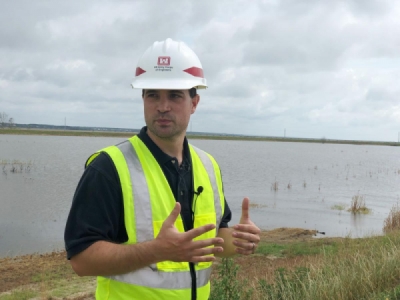
Posted on June 11, 2019
Regular maintenance to the Atlantic Intracoastal Waterway (AIWW) is required for recreational and commercial boats to make their way up and down the body of water along the coast of Charleston. Without regularly scheduled dredging maintenance, the waterway would fill with sand, silt and sediment preventing boats from passing through at low tide.
Recently, the Charleston District U.S. Army Corps of Engineers started using congressional funds to alleviate this concern for boaters. Several dredging companies they contracted have been pumping material from the bottom of the waterway at Breach Inlet up onto a material placement area. The dike platform where the material is pumped is directly across from Isle of Palms and Sullivan’s Island at Breach Inlet.
“We as a part of our mission with Army Corps of Engineers, want to be able to provide safe, efficient transport on all of our federal channels. So that’s what we’re trying to do on the waterway,” said Jeremy Johnson, project manager for the Charleston District U.S. Army Corps of Engineers.
As part of maintaining the waterway a survey crew samples conditions every 6-12 months. The Army Corps of Engineers then takes the data to develop the maintenance dredging contracts. Then, when federal funds are available, they highlight critical areas and dredge to authorized depth of the AIWW which is 12-feet deep at low tide.
Johnson explained this is a process of Mother Nature where sediment runs down from the mountains, goes through the rivers and hits coastal inlets. Sometimes this results in the sediment building up in some of the critical areas in the AIWW. He said Breach Inlet is one of the more dynamic areas on the waterway in South Carolina and they actually dredged the same area about two to three years ago.
The contractors utilize a big rotating cutter that sits on the bottom of the channel rotates to break the mud and sediment. Once it’s broken up it’s then sucked up through a pump and up a pipeline onto the dredging material placement area, according to Johnson. He explained there are no concerns of aquatic life being harmed by the cutter due to the travel lanes they are working within. He also said the U.S. Army Corps of Engineers is in compliance with any local, state and federal environmental coordination as they work in the federal channel.
“We’re not dredging the entire waterway from bank to bank of the river, we’re only dredging inside the U.S. Coast Guard marked federal channel. Within that channel, we only highlight critical areas that need to be dredged,” Johnson added.
Currently, the Charleston District U.S. Army Corps of Engineers is dredging the Intracoastal Waterway from Charleston to Georgetown. They recently finished dredging project Port Royal to Charleston before starting on Breach Inlet. Johnson expects the Breach Inlet dredging work to be wrapped up by the end of June and the entire dredging projects going on between to Georgetown to wrap up by the end of 2019.
The complete list of shoals in proximity to the AIWW within the federal channel they are dredging are:
- Breach Inlet
- Capers Inlet
- Graham Creek
- Awendaw Creek
- Matthews Cut
- South Santee
- Four Mile Creek
- North Santee
- Little Crow Island
- Minim Creek
- South Island Ferry
They are also dredging Jeremy Creek under this contract.
The dredging at Breach Inlet will move 500,000 cubic yards of material which is equivalent to 50,000 dump trucks of silt, sand, sediment from the bottom of the federalc channel. Overall, they’re removing 1.5 million cubic yards of material between Charleston and Georgetown on the AIWW.
By the time the Breach Inlet project is complete, Johnson expects the placement area they are pumping the sediment and water up onto to look completely different.
Placement areas are what the Army Corps of engineers uses to maintain the waterway and they need maintenance as well, Johnson explains. After the water flows back out to the AIWW and the placement area is drained and dries, the Army Corps of Engineers will issue a new contract for earth moving equipment to come in. This equipment will move the material from the inside the placement area to build up the perimeter dike for more capacity and opportunities for more dredging.
Johnson said the waterway sees smaller cargo ships than those that travel through the Charleston Harbor and barges delivering material. Recreation vessels such as large yachts and fishing boats also travel the waterway. He also explained the Army Corps is cleaning these areas on the AIWW so that at low tide, no mater where people travel through the waterway they’re safe.
“Anybody that’s a seasoned user of the waterway knows that communication is important. On all of our contracts we follow Coast Guard regulations and policies. As boaters are getting close to the dredge, we ask them to communicate like they would with any other vessel,” Johnson said.
The size of the watercraft passing the dredge doesn’t particularly matter. Johnson said for the safety of the crew working on this dredging project and the safety of citizens, everyone should make the dredge aware when they are coming by.
“It (the dredging project) is important to us as the federal government. It’s important to the users of the waterway to know that the U.S. Army Corps of Engineer as part of our mission with the federal government, are providing safe, reliable and efficient transportation for both commercial and recreation users,” Johsnon added.
Source: coastalnewstoday.com





